Abstract
Background:
Photomicrographs in Anatomic Pathology provide a means of quickly sharing information from a glass slide for consultation, education, documentation and publication. While static image acquisition historically involved the use of a permanently mounted camera unit on a microscope, such cameras may be expensive, need to be connected to a computer, and often require proprietary software to acquire and process images. Another novel approach for capturing digital microscopic images is to use smartphones coupled with the eyepiece of a microscope. Recently, several smartphone adapters have emerged that allow users to attach mobile phones to the microscope. The aim of this study was to test the utility of these various smartphone adapters.
Materials and Methods:
We surveyed the market for adapters to attach smartphones to the ocular lens of a conventional light microscope. Three adapters (Magnifi, Skylight and Snapzoom) were tested. We assessed the designs of these adapters and their effectiveness at acquiring static microscopic digital images.
Results:
All adapters facilitated the acquisition of digital microscopic images with a smartphone. The optimal adapter was dependent on the type of phone used. The Magnifi adapters for iPhone were incompatible when using a protective case. The Snapzoom adapter was easiest to use with iPhones and other smartphones even with protective cases.
Conclusions:
Smartphone adapters are inexpensive and easy to use for acquiring digital microscopic images. However, they require some adjustment by the user in order to optimize focus and obtain good quality images. Smartphone microscope adapters provide an economically feasible method of acquiring and sharing digital pathology photomicrographs.
Keywords: Digital pathology, digital photomicrography, smartphone microscope adapters
INTRODUCTION
In anatomic pathology, static photomicrographs of glass slides form an important mode of sharing information for consultations, education and publications. Static images are also an important means to document pathology findings. Microscopic image acquisition historically involved the use of a permanently mounted camera unit on a microscope. This may be accomplished by attaching a camera to an ocular lens or to a port in a trinocular head using a C-mount adapter. Oftentimes, the camera is attached to the 2-headed end of a microscope. For digital cameras, image sensors as well as required additional optics are housed within the mounted camera, which stores the images in a smart card for later transfer or communicates to a computer to relay a static digital image or streaming of an image. The yield is a high quality digital image, saved to a disk in a commonly used image file format (e.g. JPEG, or TIFF). These camera units often require companion image processing software (e.g. firmware), which allows for automatic and manual image management and manipulation. This system requires significant financial investment for the camera unit and its accessories (C-mount adapter, connection cables, image capture card and accompanying software). A computer and a compatible eyepiece unit to which the camera can be attached are mandatory, which can potentially add overhead costs.
Two main types of camera sensors are typically used to attach to microscopes – charged couple devices (CCD) and complementary metal oxide semiconductor (CMOS) sensors.[1] Historically, CCD cameras were preferable for the highest quality image. However, CMOS cameras have narrowed the difference in quality and essentially are equivalent for the majority of photomicrographs. Both types of sensors capture more pixels than is often necessary for acquiring optimal photomicrographs.[1]
When smartphones were introduced, these phones had integrated cameras utilizing CMOS sensors. With each generation of smartphone, there has been a significant improvement in their hardware and software specifications.[2] Cell phone cameras, in particular, have undergone significant improvements with each new phone release. They are potentially suitable for high quality image acquisition of photomicrographs taken from glass slides via a microscope. Not surprisingly, investigators recently studied the use and quality of image capture using smartphone cameras from bright-field and fluorescent microscopes.[3,4,5,6] Both Apple's iPhone and Google's Android based smartphones have been studied for this purpose. Images were captured either using manual positioning of the phone's camera up against the microscope's eyepiece,[3] or by using a modified handheld imaging device for image capture (without using a microscope).[6,7]
Given the high quality of digital cameras currently available with smartphones, numerous adapters have been developed to help capture images from devices with oculars (e.g. binoculars, telescopes, microscopes), predominantly for leisure-based activities. These activities include bird watching, hunting, astronomy, surfing and microscopy. This technical note presents the authors’ experiences with various smartphone adapters for microscopic image acquisition.
TECHNICAL BACKGROUND
For the purpose of this study, we compared three recently developed smartphone adapters [Figure 1]; Magnifi (Arcturus Labs, LLC, Palo Alto, CA),[8] Skylight (Skylight Healthcare Systems, Oakland, CA),[9] and Snapzoom (HI Resolution Enterprises, Honolulu, HI).[10] The first two adapters have been engineered specifically to facilitate smartphone image acquisition from a microscope.
Figure 1.

Smartphone microscope adapters. (a) Magnifi adapter (b) Skylight adapter (c) Snapzoom adapter
Magnifi is a compact adapter specifically designed for iPhones (4, 4S and 5) [Figure 2a]. It consists of two components – an iPhone case fabricated from impact-resistant polycarbonate plastic, which fits the phone using stainless steel bands (FeatherGlide) and a detachable microscope eyepiece adapter. The adapter securely fits the case using Magnifi's unique Bayonet mount. The mount, together with the case, facilitates alignment of the iPhone's camera with the eyepiece lens. Flexible rubber rings are shipped with the adapter to facilitate secure fitting with a range of eyepiece sizes (25 mm-38 mm eyepiece diameter).
Figure 2.
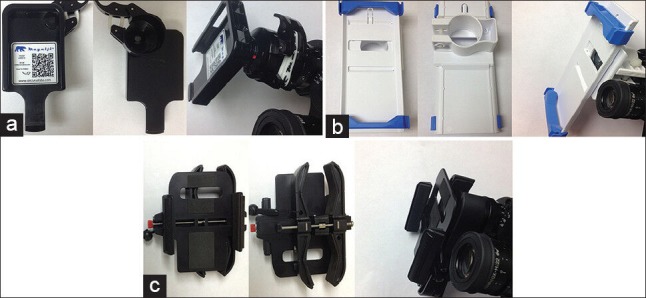
Select images of smartphone adapters that can be mounted onto a microscope. (a) Magnifi adapter (b) Skylight adapter (c) Snapzoom adapter
The second adapter is Skylight, which is designed to accommodate a range of smartphones of various sizes, including the iPhone, to facilitate microscopic imaging [Figure 2b]. It also consists of two components: a stage, which holds the smartphone, and an eyepiece adapter, which slides into the stage. The stage holds the phone with a pair of clips and allows movement of the phone along the x- and y-axis to align the phone's camera to the eyepiece optics. In addition, the eyepiece adaptor allows minimal movement along the z-axis to optimize desired focal length. Similar to Magnifi, Skylight can also accommodate a range of eyepiece sizes.
The third adapter is Snapzoom, which is designed to accommodate a range of smartphones of various sizes [Figure 1c]. The snapzoom adapter consists of two connected parts - a stage and a binocular eyepiece adapter. The stage holds the phone and can be adjusted with metal screw adjustments. It has a similar adjustment to the Skylight along the x- and y-axis to align the phone's camera to the eyepiece optics. The stage can accommodate all major smartphones with or without cases that are up to 3.5 inches in width. The eyepiece adapters can mount to eyepieces up to 2 inches in outside diameter.
USER EXPERIENCE
Practicing pathologists as well as trainees at our institution evaluated the three adapters for usability, image quality and potential use in a low resource setting. We also compared these adapters with adapter-free image capture as described by Bellina and Missoni[3] and standard permanent mounted digital cameras (Spot Digital Microscope Cameras, Spot Imaging Solutions, MI, USA). Features that were evaluated are summarized in Table 1. The optimal smartphone adapter was dependent on the type of smartphone used. For non-iPhone smartphones or iPhones with a protective case, the ability of the adapters to be optimally adjusted for image acquisition was difficult. Specifically, there are two considerations to make – coupling the smartphone with the adapter before image acquisition [referred to as “ease of use” in Table 1] and smartphone optimization for image acquisition. The first consideration involves the ability of the smartphone adapter to require limited adjustment each time the smartphone is attached and/or removed. The variability in the required adjustment for each adapter reflected the time required for coupling the smartphone. For a given user, since the phone and the adapter used were not expected to change frequently, the user experience with initial setup was improved after repeated use. The second consideration involves the initial setup of the adapter. Specifically, we found that the settings for the Skylight tended to slip with manipulation of the adapter. For Table 1, this consideration is termed “stability of the adapter.” While manufacturers of these adapters have created cases as part of the adapter for iPhones, which is convenient, they are incompatible when there is a protective case on the phone.
Table 1.
Comparison of various smartphone adapters
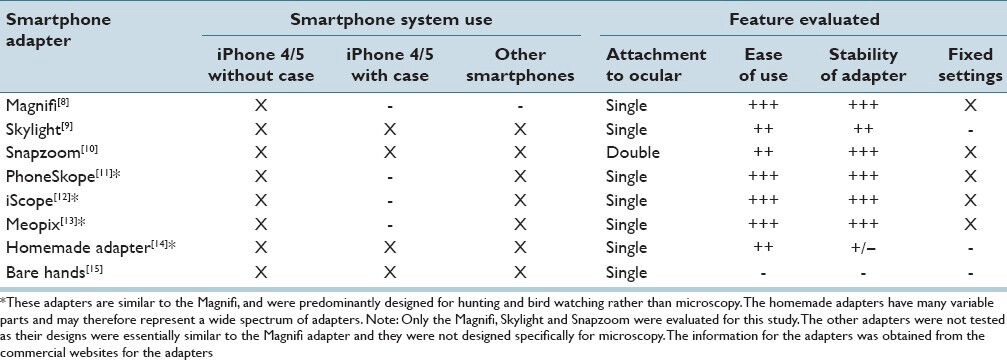
For image acquisition, several factors affect the ability to generate an optimal image. The image acquired with the adapter is the same image as seen through the ocular lens. The factors contributing to image quality include: (a) Proper alignment of the camera lens and ocular lens, (b) resolution of the image, (c) focal length of the camera on the smartphone, and (d) specific smartphone settings (such as shutter speed and autofocus/autoadjust settings). Many of these factors are widely variable due to the nature of the smartphone model used. Resolution is largely affected by the microscope upon which the images are captured. For instance, a microscope with suboptimal optics will produce a poorer quality image than a microscope with better optics (e.g. objective with higher numerical aperture). Optimizing for camera focal length can be adjusted in one of two ways. For users working with Skylight or Snapzoom, spacers (provided with the adapter) can be inserted between the camera and the ocular, thus increasing the distance of the camera to the ocular lens. However, there is a fixed distance to the lens that cannot be overcome, if you need the camera to be closer to the ocular lens. The user may also use the digital zoom that is standard within most smartphone cameras. For the native setting of the smartphone camera, corner shadowing was present around the edges because the smartphone camera takes a rectangular image rather than a circular image (ocular lens shape), so-called “vignetting”. This vignetting can be overcome by utilizing the digital zoom before image acquisition or during post-processing [Figures 3a and c]. Using these functions can decrease the resolution of the image acquired, but do not affect the overall quality of the image obtained [Figures 3b and d]. The use of digital zoom to correct for vignetting cannot be used in conjunction with video image capture in the iPhone 4/4S phones. New updates to the iPhone have included the option of “square” photographs; however, this does not prevent this vignetting. Hand-held positioning allows for setting the camera in any location, but this produces variability between captured images and is cumbersome. Digital microscopic images of cytopathology and fluorescent in situ hybridization can also be captured using these smartphone adapters [Figure 4]. Although image capture represents the first step, numerous post-processing tools exist for both mobile and desktop post-processing. Optimal post-processing software is beyond the scope of this discussion. Streaming of digital images from smartphones attached to microscope coupled with video calls was demonstrated to be feasible [Figure 5].
Figure 3.
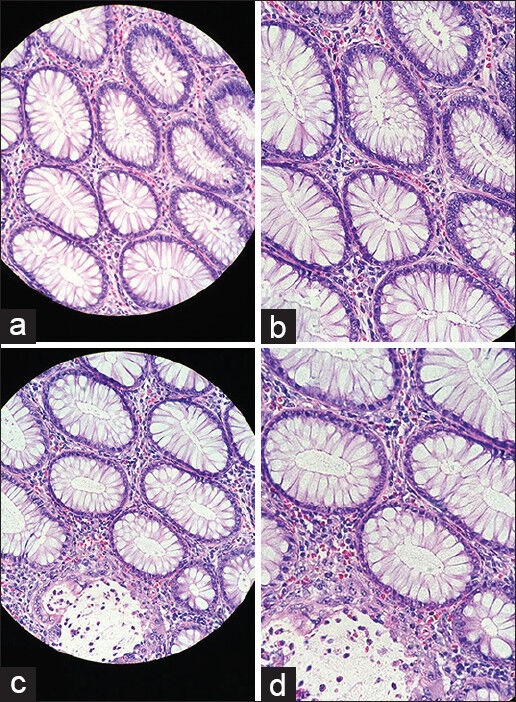
Comparison of digital images acquired using two adapters methods. (a and b) Images of colonic mucosa taken on an iPhone with Magnifi adapter at high power without (a) and with digital zoom (b) (Hematoxylin and Eosin, ×400) (c and d) Images of colonic mucosa taken on an iPhone with Skylight adapter at high power without (c) and with digital zoom (d) (Hematoxylin and Eosin, ×400)
Figure 4.
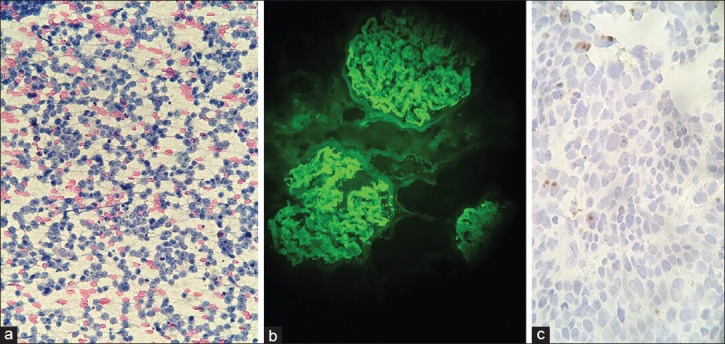
Digital images captured from various types of specimens. (a) Cytology specimen showing lymphoma captured at high power using an iPhone and the Skylight adapter with digital zoom (Papanicolaou stain, ×400). (b) Fluorescence in situ hybridization (FISH) for IgG in a renal biopsy captured using an iPhone and the Magnifi adapter (IgG FITC, ×200). (c) In situ hybridization for HPV at 400 × captured with a Motorola Droid using Snapzoom adapter (HPV in situ hybridization, ×400)
Figure 5.
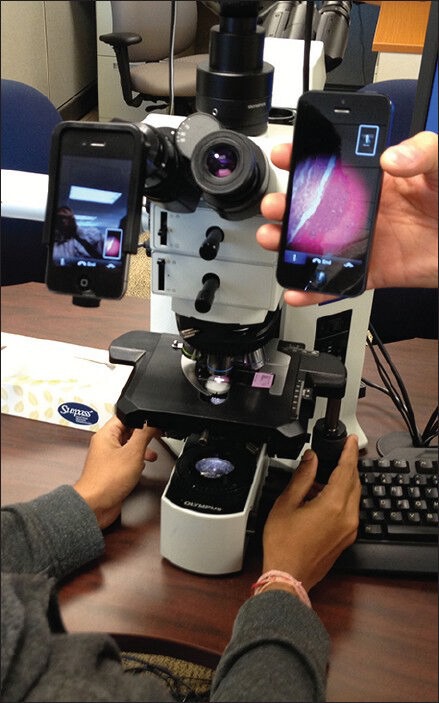
Live video transmission of a digital image is shown from a cell phone attached to a microscope with the Magnifi adapter
While camera resolution was quite good on the phones tested, image and video capture software did pose limitations and resulted in some differences between smartphones. The native camera capture software present on the devices was utilized in this study. Subjectively, the image quality seemed to be slightly superior with the iPhone versus the Droid smartphone, however, both obtained adequate images. Third-party software may improve the quality and/or add functionality to the image once acquired. Additionally, the native video capture software present within smartphones is quite basic and limited the ability of using video capture with the adapters although it can be done. The native video capture software does not allow for pausing while objectives are switched. When you switch between objectives, the image view becomes flooded with light but adjusts in 5-10 sec. The Droid smartphone adjusted to these changes in light more rapidly than did the iPhone. The Droid smartphone allows for video capture while zoomed in. Presumably, in future iterations this software will improve and facilitate video capture more readily.
Utilization of a smartphone camera and adapter for imaging an entire day's workload is not feasible as we found that using the adapters lengthened the time to preview cases. In particular, the mounting and dismounting of the adapters from the microscope in order to switch between obtaining images and viewing the slides through the eyepiece with both eyes lengthened the sign out time period. For some cases, the adapters needed to be readjusted with each reattachment. Some users felt that these adjustments were cumbersome enough to justify capturing images by simply handholding of the smartphone. As an alternative, the use of double-headed or multiheaded eyepiece mounts can potentially optimize this process, wherein the adapter is permanently attached to one of the eyepieces, requiring minimal coupling and uncoupling of the smartphone.
CONCLUSION
The adoption of smartphones as acquisition devices for pathology photomicrographs is appealing, given their widespread availability, connectivity to the Internet and feasibility of quickly taking a snapshot when needed. There are numerous possible applications for which acquisition of images via a smartphone may be ideal: (a) Capturing images for tumor board presentation, (b) sharing occasional interesting cases for educational purposes, (c) for rapid consultations, such as for frozen sections, (d) screening select cases to assess the need for submitting the entire case for consultation, (e) for quality assurance to document using static images, and (f) for submitting static images of single microscopic fields for teleconsultation. Several other authors have found that the images acquired via cellphone adapters are comparable with standard captured images.[16,17] In the appropriate setting, we recommend the use of the Magnifi or Snapzoom smartphone adapter to leverage smartphone cameras that many pathologists carry around with them. The use of smartphone adapters represents a novel solution for capturing digital images in low-resource environments or for rapid, focused consultation purposes.
Footnotes
Available FREE in open access from: http://www.jpathinformatics.org/text.asp?2014/5/1/24/137728
REFERENCES
- 1.Park S, Pantanowitz L, Parwani AV. Digital imaging in pathology. Clin Lab Med. 2012;32:557–84. doi: 10.1016/j.cll.2012.07.006. [DOI] [PubMed] [Google Scholar]
- 2.Park S, Parwani A, Satyanarayanan M, Pantanowitz L. Handheld computing in pathology. J Pathol Inform. 2012;3:15. doi: 10.4103/2153-3539.95127. [DOI] [PMC free article] [PubMed] [Google Scholar]
- 3.Bellina L, Missoni E. Mobile cell-phones (M-phones) in telemicroscopy: Increasing connectivity of isolated laboratories. Diagn Pathol. 2009;4:19. doi: 10.1186/1746-1596-4-19. [DOI] [PMC free article] [PubMed] [Google Scholar]
- 4.Breslauer DN, Maamari RN, Switz NA, Lam WA, Fletcher DA. Mobile phone based clinical microscopy for global health applications. PLoS One. 2009;4:e6320. doi: 10.1371/journal.pone.0006320. [DOI] [PMC free article] [PubMed] [Google Scholar]
- 5.McLean R, Jury C, Bazeos A, Lewis SM. Application of camera phones in telehaematology. J Telemed Telecare. 2009;15:339–43. doi: 10.1258/jtt.2009.090114. [DOI] [PubMed] [Google Scholar]
- 6.Zhu H, Yaglidere O, Su TW, Tseng D, Ozcan A. Cost-effective and compact wide-field fluorescent imaging on a cell-phone. Lab Chip. 2011;11:315–22. doi: 10.1039/c0lc00358a. [DOI] [PMC free article] [PubMed] [Google Scholar]
- 7.Tseng D, Mudanyali O, Oztoprak C, Isikman SO, Sencan I, Yaglidere O, et al. Lensfree microscopy on a cellphone. Lab Chip. 2010;10:1787–92. doi: 10.1039/c003477k. [DOI] [PMC free article] [PubMed] [Google Scholar]
- 8.Arcturus Labs LLC. Palo Alto, CA: [Last cited on 2014 Mar 27]. Arcturuslabs.com [Internet] Available from: http://www.arcturuslabs.com . [Google Scholar]
- 9.Skylight Healthcare Systems. Oakland, CA: [Last cited on 2014 Mar 27]. Skylightscope.com [Internet] Available from: http://www.skylightscope.com . [Google Scholar]
- 10.HI Resolutions Enterprises. Honolulu, HI: [Last cited on 2014 Mar 27]. Snapzooms.com [Internet] Available from: http://snapzooms.com . [Google Scholar]
- 11.Beaver, UT: Davcomm LLC; [Last cited on 2014 Mar 27]. Phoneskope.com [Internet] Available from: http://www.phoneskope.com . [Google Scholar]
- 12.Sikeston, MO: iScope LLC; [Last cited 2014 Mar 27]. iScope.com [Internet] Available from: http://www.iscope.com . [Google Scholar]
- 13.Hauppauge, NY: Meopta, USA, Inc; [Last cited on 2014 Mar 27]. Meoptasportsoptics.com [Internet] Available from: http://www.meoptasportsoptics.com/shop/us/4-4s-iscoping-adapter/pxdpgdce72jh/ctgMPus.html . [Google Scholar]
- 14.Instructables.com (Homemade Adapter) [Internet]. Posted by username: philslizzy. [Last cited on 2014 March 27]. Available from: http://www.instructables.com/id/microscope-adapter-for-cell-phone .
- 15.Morrison AS, Gardner JM. Smart phone microscopic photography: A novel tool for physicians and trainees. Arch Pathol Lab Med. 2013 doi: 10.5858/arpa.2013-0425-ED. [DOI] [PubMed] [Google Scholar]
- 16.Wimmer J, Dhurandhar B, Fairley T, Ramsaywak J, Scheiber-Pacht M, Satrum L, et al. A novel smartphone-microscope camera adapter: An option for cytology consultation in low-resource environments. J Am Soc Cytopathol. 2012;1:S124–5. [Google Scholar]
- 17.Lehman JS, Gibson LE. Smart teledermatopathology: A feasibility study of novel, high-value, portable, widely accessible and intuitive telepathology methods using handheld electronic devices. J Cutan Pathol. 2013;40:513–8. doi: 10.1111/cup.12108. [DOI] [PubMed] [Google Scholar]


